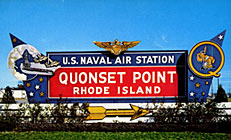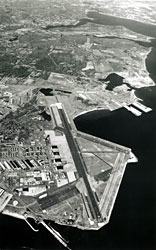 | ||||||
 |
Policy and ManagementQuonset Point Development
(Courtesy of Quonset Air Museum http://users.ids.net/~qam/qam/) (Click for larger image) Quonset Point, located in North Kingstown, has been associated with military activities for over a hundred years. This dates back to 1780 when the British ship, Armada, came ashore here loaded with supplies for the British Navy and Army. The area that is now Quonset Point was one of the earliest settlements in North Kingstown. The land consisted of farms, wooded areas, and a vineyard. Along the coastline, there were summer cottages and a camp for underprivileged kids. In the late 1800s, Quonset Point was bought by the state of Rhode Island from private landowners. In 1937, a large portion of the land was donated by Rhode Island to the Federal Government and the properties on the land were cleared to make room for the construction of the Navy base. During World War I, Quonset Point was used as a training ground for the U.S. military. In 1940, Quonset Point became an active Naval Air Station due to a need for new bases on the east coast. It was homebase for seaplane squadrons and several carrier airwings. Construction of the famous Quonset Huts took place at this time as well. The Quonset Hut was a semicircular corrugated steel building that was designed to be inexpensive to build, quick to manufacture, and lightweight to ship. It was a universal building that was used for barracks, hospitals, kitchens, warehouses, and latrines. During the Second World War, Quonset was involved in the development of a Naval night fighter aircraft. After the war, Quonset Point saw a depletion in ships on the base. It then went on to become a Naval Air Rework Facility, where it specialized in reciprocating engines and repaired and manufactured Naval aircrafts. Eventually there was no longer a need for the rework facility and the Naval Air Station closed in 1974. The Navy declared most of Quonset Point surplus to its needs and the land and buildings were offered to the State of Rhode Island and North Kingstown for civilian use. In the late 1970s efforts began to turn Quonset Point into an industrial park, but since then, they have been only partly successful. 
Aerial view of Naval Air Station-Quonset Point and Davisville in the late 1950's (Courtesy of Quonset Air Museum, http://users.ids.net/~qam/qam/) (Click for larger image) In 1991, the Navy requested that a local "base reuse committee" be created to turn the existing Navy base to civilian use. In 1994, the Navy base was officially closed. In July 1998, a group of developers created the Quonset Port Partners (QPP) and contracted with the state to develop a containerized cargo terminal at Quonset Point. The development stopped in September 1998 when the state did not accept the QPP's development proposal because "the developers need financial agreements from carriers in order for the state to accept the proposal." In September 1999, RK Johns and Associates was commissioned by Governor Lincoln Almond and the R.I. Economic Development Council (EDC) to complete the Quonset Point Feasibility Study. It is expected that Governor Almond will submit a budget request to the General Assembly requesting funding to pursue a federal Environmental Impact Study (EIS), the first major step in the environmental permitting process. (See Save the Bay at http://www.savethebay.org/bayissues/quonset/index.htm) Rumors also persist that port advocates in the General Assembly will forward a port authority bill this session. The significance of the creation of a port authority is that it would have the power to make decisions regarding the future of the Bay and its ports without requiring the consent of the voting public. The concerns of local residents for a container port are manifold. With regard to Narragansett Bay's ecosystem, there are issues of light pollution from the port, noise pollution from the ships, increased erosion from the wake of increased number of ships, greater potential for oil spills, and the introduction of invasive species from ballast water, just to name a few. The indirect effects of these impacts could include reduced tourism, and a decline in commercially- or recreationally-important fisheries. Different forms of the container port plan also include the possibility of filling in parts of the Bay, thereby destroying shallow water habitats that are potentially important for fishes such as winter flounder.
|
|||||